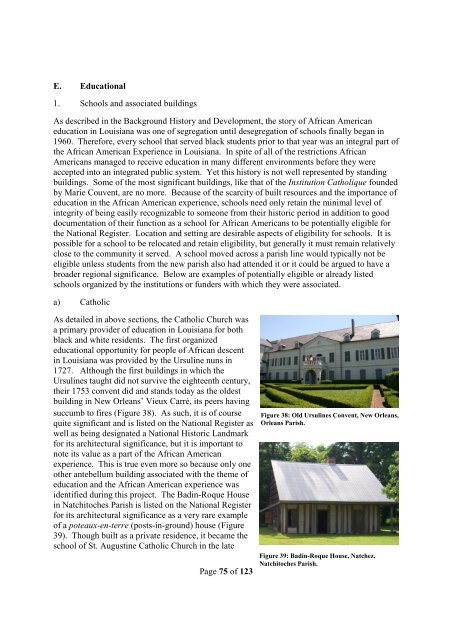The African American Experience in Louisiana
The_African_American_Experience_in_Louisiana
The_African_American_Experience_in_Louisiana
- No tags were found...
Create successful ePaper yourself
Turn your PDF publications into a flip-book with our unique Google optimized e-Paper software.
E. Educational<br />
1. Schools and associated build<strong>in</strong>gs<br />
As described <strong>in</strong> the Background History and Development, the story of <strong>African</strong> <strong>American</strong><br />
education <strong>in</strong> <strong>Louisiana</strong> was one of segregation until desegregation of schools f<strong>in</strong>ally began <strong>in</strong><br />
1960. <strong>The</strong>refore, every school that served black students prior to that year was an <strong>in</strong>tegral part of<br />
the <strong>African</strong> <strong>American</strong> <strong>Experience</strong> <strong>in</strong> <strong>Louisiana</strong>. In spite of all of the restrictions <strong>African</strong><br />
<strong>American</strong>s managed to receive education <strong>in</strong> many different environments before they were<br />
accepted <strong>in</strong>to an <strong>in</strong>tegrated public system. Yet this history is not well represented by stand<strong>in</strong>g<br />
build<strong>in</strong>gs. Some of the most significant build<strong>in</strong>gs, like that of the Institution Catholique founded<br />
by Marie Couvent, are no more. Because of the scarcity of built resources and the importance of<br />
education <strong>in</strong> the <strong>African</strong> <strong>American</strong> experience, schools need only reta<strong>in</strong> the m<strong>in</strong>imal level of<br />
<strong>in</strong>tegrity of be<strong>in</strong>g easily recognizable to someone from their historic period <strong>in</strong> addition to good<br />
documentation of their function as a school for <strong>African</strong> <strong>American</strong>s to be potentially eligible for<br />
the National Register. Location and sett<strong>in</strong>g are desirable aspects of eligibility for schools. It is<br />
possible for a school to be relocated and reta<strong>in</strong> eligibility, but generally it must rema<strong>in</strong> relatively<br />
close to the community it served. A school moved across a parish l<strong>in</strong>e would typically not be<br />
eligible unless students from the new parish also had attended it or it could be argued to have a<br />
broader regional significance. Below are examples of potentially eligible or already listed<br />
schools organized by the <strong>in</strong>stitutions or funders with which they were associated.<br />
a) Catholic<br />
As detailed <strong>in</strong> above sections, the Catholic Church was<br />
a primary provider of education <strong>in</strong> <strong>Louisiana</strong> for both<br />
black and white residents. <strong>The</strong> first organized<br />
educational opportunity for people of <strong>African</strong> descent<br />
<strong>in</strong> <strong>Louisiana</strong> was provided by the Ursul<strong>in</strong>e nuns <strong>in</strong><br />
1727. Although the first build<strong>in</strong>gs <strong>in</strong> which the<br />
Ursul<strong>in</strong>es taught did not survive the eighteenth century,<br />
their 1753 convent did and stands today as the oldest<br />
build<strong>in</strong>g <strong>in</strong> New Orleans’ Vieux Carré, its peers hav<strong>in</strong>g<br />
succumb to fires (Figure 38). As such, it is of course<br />
quite significant and is listed on the National Register as<br />
well as be<strong>in</strong>g designated a National Historic Landmark<br />
for its architectural significance, but it is important to<br />
note its value as a part of the <strong>African</strong> <strong>American</strong><br />
experience. This is true even more so because only one<br />
other antebellum build<strong>in</strong>g associated with the theme of<br />
education and the <strong>African</strong> <strong>American</strong> experience was<br />
identified dur<strong>in</strong>g this project. <strong>The</strong> Bad<strong>in</strong>-Roque House<br />
<strong>in</strong> Natchitoches Parish is listed on the National Register<br />
for its architectural significance as a very rare example<br />
of a poteaux-en-terre (posts-<strong>in</strong>-ground) house (Figure<br />
39). Though built as a private residence, it became the<br />
school of St. August<strong>in</strong>e Catholic Church <strong>in</strong> the late<br />
Page 75 of 123<br />
Figure 38: Old Ursul<strong>in</strong>es Convent, New Orleans,<br />
Orleans Parish.<br />
Figure 39: Bad<strong>in</strong>-Roque House, Natchez,<br />
Natchitoches Parish.


